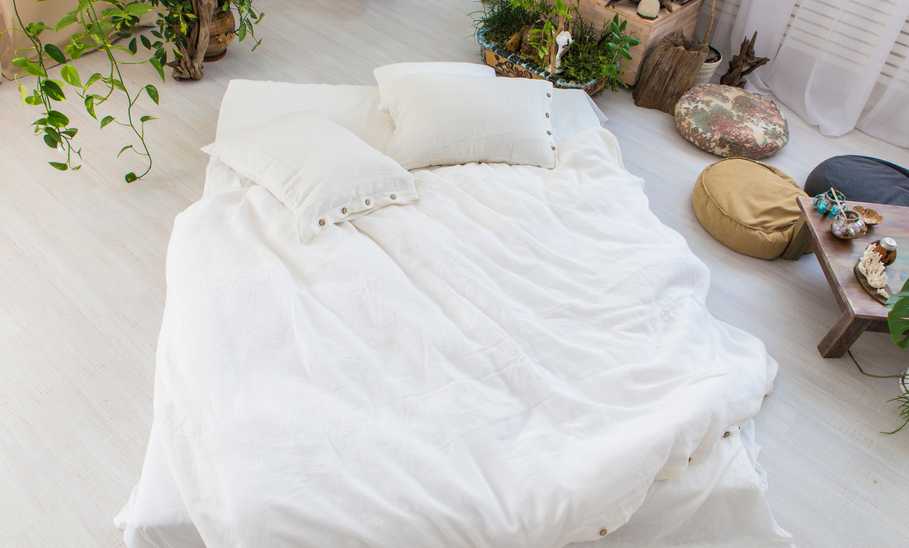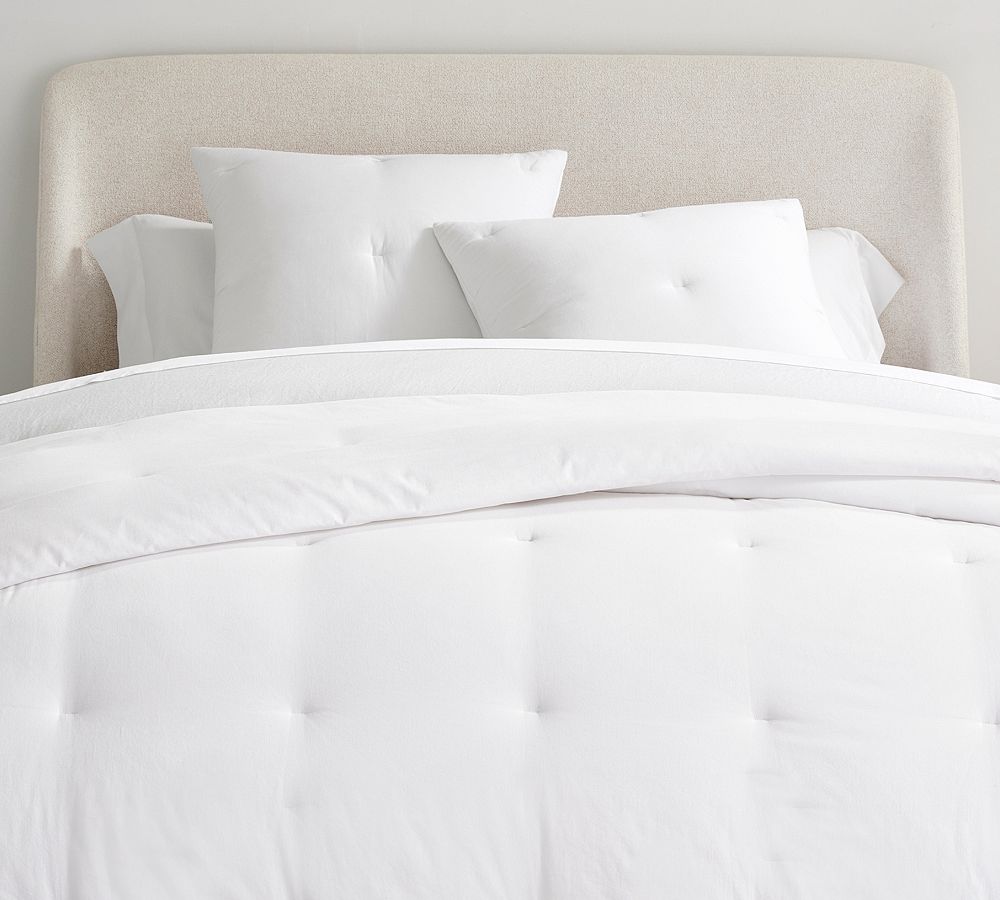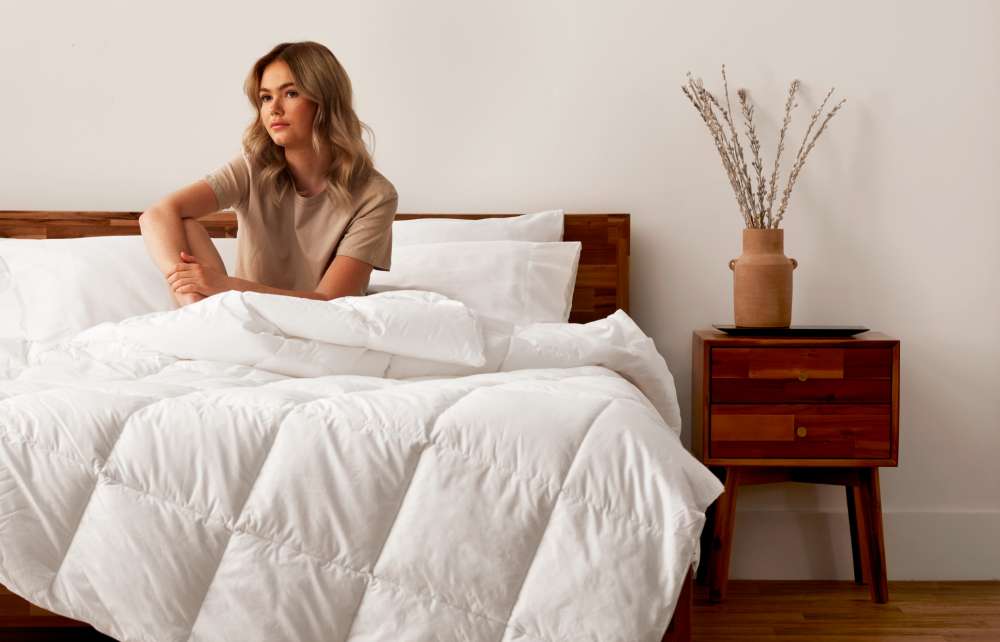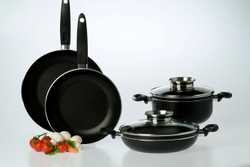Best Down Alternative Comforters for Allergy Sufferers Everywhere

Our evaluations and opinions are not influenced by our advertising relationships, but we may earn a commission from our partners’ links. This content is created by TIME Stamped, under TIME’s direction and produced in accordance with TIME’s editorial guidelines and overseen by TIME’s editorial staff. Learn more about it.
For many, sleep can be elusive, and finding the right bedding options—including tracking down both the best down pillows and the best down comforters—often proves to be a lengthy process. For those who suffer from allergies, or simply don’t like the idea of using animal-based products, it’s even harder. The good news is that many brands have started to come around on the idea of down alternative fills, producing quality options that are also often more affordable than down.

The Puredown All Seasons Comforter features a sewn-through construction to keep the polyester fiber fill from shifting around inside. It has corner loops to attach to a duvet cover and an edge finished with piping, which helps ensure none of the fiber will work its way out through the edges. It's Oeko-Tex certified, meaning it’s free from harmful materials, and it’s machine-washable in cold water, so you don’t have to worry about schlepping it to a professional cleaner.
A polyester fiber-filled all season comforter featuring quality construction details at a great, budget-friendly price.
Made with hypoallergenic, microfiber synthetic fill, this comforter from Quince provides the feel of down without the sneezing and stuffy nose experienced by those susceptible to allergies—and the quality for the price point makes it a really good value. The baffle box construction keeps the fill evenly distributed and the corner loops allow you to secure it to a cover, although with the soft, 100% cotton sateen cover material, you may not want to. And, since it's completely machine washable, you don’t have to, either. (Check out our guide to how to wash comforters for the best way to keep your purchase looking fresh.)
An all-season down alternative comforter with a microfiber, synthetic fill, and breathable 100% cotton shell that’s great for those prone to allergies.

Buffy’s down alternative comforter is made from Tencel lyocell* and features a tear drop-shaped, through-stitching pattern and a fill made from recycled plastic water bottles (each comforter contains the equivalent of approximately 50 plastic bottles). Unlike most comforters that use loose down or polyester fibers, this one consists of multiple fine layers of fill–105 to be exact. This means there are no cold spots caused by the fill shifting. Corner loops easily attach to a duvet cover and the eucalyptus makes it exceptionally breathable for hot sleepers.
*Like viscose, Tencel refers to the process of taking wood (in this case eucalyptus) and breaking it down in a chemical solution until it becomes a pulp that can be made into fibers. Tencel creates its material using a sustainable closed loop process that recovers the water and 99.8% of the chemicals used.
Eco-conscious, comfy, alternative down comforter made from eucalyptus lyocell with a PET fiber fill.

Meticulously sewn with baffle box construction and double stitching in the edges, Parachute’s down alternative comforter offers a durable, beautifully made lightweight option for warmer nights and hot sleepers. The 100% cotton sateen shell adds breathability while the hypoallergenic microfiber fill alleviates most possibilities of allergic reactions. The company, known for its minimalist, luxurious products, offers a 60-day return policy and a 5-year warranty.
Lightweight, yet still fluffy and cozy down alternative comforter made with a cotton shell and microfiber fill.

Made from bamboo viscose*, this Cozy Earth comforter is breathable and luxurious. Bamboo, an exceptionally soft fabric, has both natural temperature-regulating and moisture-wicking properties. As an allergy sufferer who doesn’t like polyester, I purchased this comforter when looking for a quality down alternative and love how soft it is while still having weight behind it. I’ve used it through all seasons, and it keeps me cool through the summer and warm during the winter.
*Viscose refers to the process by which trees are made into fabric (or a fill) and consists of first steeping the stalks in a solution that renders them pliable, then performing a series of additional steps including shredding, aging, filtering, washing, and spinning. While making viscose is not considered to be very eco-friendly by some, Cozy Earth only works with factories that recycle the water and recaptures the chemicals used in the viscose process.
This 100% bamboo viscose (both shell and fill) comforter delivers a soft, luxurious feel from a company that strives to be eco-conscious and sustainable.

The Pottery Barn Dream Brushed Cotton Comforter features a tuft construction for a fluffier, loftier appearance and feel. Instead of lines of stitching through the layers or an internal baffle box, a tufted construction offers a series of single stitch points placed at equal distances throughout the material. This is the same construction method used often in upholstery, usually with a button to secure the stitches. Basically, if you love a comforter with a lot of puff, you’ll love this one. The other cool thing about this comforter is that the fill includes a material called repreve, made from recycled plastic bottles. If you want to learn more about how plastic waste becomes fiber, you can read about it here on Unifi’s website, a company that makes a variety of products from plastic waste.
A fluffy, luxurious down alternative comforter made with a tufted construction and featuring a fill that contains recycled plastic bottles.

Featuring a vegan, microfiber fill, this down alternative comforter from Silk and Snow is comfortable, incredibly soft, and free from harmful materials (it's Oeko-Tex certified). It’s constructed with square baffle boxes to keep the fill evenly distributed, clump-free, and lofty. The 100% cotton cover adds breathability with a soft feel. It’s also available in three weights: Lightweight, all season, and winter. Silk and Snow offers a 100-night trial period, meaning you can return it for a refund or exchange as long as it remains in a donatable condition (no tears, unsightly stains, or weird odors).
A down alternative comforter with a vegan microfiber fill, cotton shell, and 100-night trial period.

Stuffed with their exclusive recycled polyester fill, Loftaire, this down alternative comforter from The Company Store is perfect for those in the “I’m always freezing” camp. The sateen cotton shell means it’s still breathable and the baffle box construction ensures all the lofty fluffiness remains equally distributed. It’s available in three thicknesses: Medium, extra, and ultra. You can use this comforter on its own or attach it to a duvet cover via the corner loops.
Super warm, lofty comforter made with a recycled polyester fill and cotton sateen shell.

Filled with a 100% PET recycled microfiber fill and constructed using a baffle box technique, the Brooklinen Down Alternative Comforter is eco-conscious and warm. The all-season version keeps you warm and cozy while being breathable, and while this comforter doesn’t require a duvet cover, it's equipped with corner loops in the event you decide to use one. One of the best reasons to purchase this comforter is Brooklinen’s return policy, which allows you to try it out for up to 365 days and still return it (for a $9.95 fee). Their dedication to customer service also earned them a spot on our list of the best places to buy bedding.
An eco-conscious, lofty, and fluffy all season down alternative comforter with a generous 365-day return policy.

Made with sustainably-produced Tencel lyocell and recycled polyester fill, this is one of The Company Store’s most eco-conscious and hypoallergenic down alternative comforters. Tencel lyocell, which is naturally resistant to dust mites and sourced from wood fibers, offers excellent breathability and temperature regulation, and feels soft against the skin. Neither too heavy nor too light, this is a wonderful medium-weight comforter. Corner loops provide attachment points if you want to add an optional duvet cover.
Sustainably manufactured, medium weight alternative down comforter, made with a soft Tencel and cotton shell and recycled polyester and Tencel fill.
Unlike other budget friendly comforters, this one features a cotton shell material instead of polyester, for more breathability. Made with a standard 10-inch square, through-stitch design and piped edges, this machine washable and dryable comforter holds up well through multiple washings. The medium weight is great for all-year use and the corner loops keep it secure when inserted into a duvet cover.
Budget-friendly, durable down alternative comforter with a breathable cotton shell.
As a tailor and pattern maker with 32 years of experience, I know a lot about textiles, fabrics, and construction techniques. While price was an important consideration for my picks, I believe you should get the best quality for your dollar. I looked for good fabrics and fill materials, studied how the comforters were sewn together, and paid attention to the ease of care. Additionally, I believe in finding well-made products from companies that value sustainability, fair trade, and environmentally-conscious practices and materials.
Everyone has different preferences when it comes to the bedding they’re most comfortable with—and those preferences can change with the season, too. To help find the best comforter for your needs, I made sure to include comforters that ranged from lightweight to heavyweight, cooling to extra warm, and everything in between.
As a journalist, in addition to being a professional tailor, pattern maker, and designer, I pay attention to how fabric is manufactured, as well as construction techniques in all kinds of soft goods, including bedding. There are reasons certain techniques are used for specific situations—some are good and some are less good, but I always like to know as much as possible about where and how a particular product came into being. To start your selection process, consider the following.
Most down alternative comforters are made with a synthetic fill, such as polyester or microfiber. Many of those included in this guide use fills created from plastic water bottles. The process to create these kinds of fill includes shredding the plastic into flakes, melting those flakes into pellets, which are then spun and pulled into yarn—quite ingenious, if you think about it.
A couple of the alternative down comforters included here are made with a Tencel bamboo or eucalyptus fill, created by fashioning wood pulp into fabric strands or sheets. These have more breathable properties than their microfiber, polyester-filled counterparts.
Most comforters are constructed either using a sewn-through or baffle box method, both of which create squares that help ensure the fill remains evenly distributed within. Sewn through means each box is formed by stitching through all layers of the comforter at once, while the baffle box method entails adding inner fabric barriers that form the containment squares.
Sewn-through comforters are usually less expensive than those made with the baffle-box technique, as they require less material overall. Baffle box comforters tend to be heavier and fluffier, as the fill has more room to move around. Which you choose is a personal choice that depends partially on your climate and how warm you yourself run.
Comforters made with sewn-through construction tend to be lighter in weight, so they may offer the best solution to people who live in warmer climates or find themselves too hot at night. That said, if you like the feel of a heavier, cozier cover, a baffle box construction may be the way to go.
A shell made from a breathable material such as cotton, bamboo, or viscose offers more temperature regulation and versatility than one made from polyester. While traditionally, the textile manufacturing of cotton and other natural fabrics has been far from sustainable, most companies today source their materials from eco-conscious factories with sustainable processes.
Most of the best comforters are available in more than one weight, or thickness. If you live in a colder climate and/or run cold yourself, consider a heavy-weight or winter comforter with a lot of loft (or fluff). For a warmer climate, you’ll likely want to look for something lightweight with less bulk.
The same buying advice, by the way, applies to duvets. For a more in-depth discussion, read our guide to duvets vs. comforters.
Down alternative comforters are available in various weights, ranging from light to heavy. Fill material can be a synthetic polyester (often made from recycled plastic bottles), bamboo or eucalyptus Tencel, or even silk or wool.
For those that suffer from allergies and/or strive to maintain an animal-free/vegan existence, an alternative down comforter is worth it. Many of them provide the same comfortable, lofty feel you’d expect from actual down without the feathers themselves.
Most down alternative comforters are machine washable, which is part of their appeal. Use cold water, mild detergent, and a gentle cycle as well as the low or air dry setting on your dryer for best results.
Choose your shell material based on how hot or cold you tend to sleep. Cotton and other natural fibers like bamboo and eucalyptus provide breathability without sacrificing warmth, while polyester options will be warmer—likely too warm for hot sleepers.
If your down alternative comforter is constructed with a breathable fabric cover made from cotton or bamboo, it shouldn’t be too hot for summer. Many companies also offer lightweight options, which are thinner with less fill, that work well in the warmer months.
The conventional rule is that you should replace your down alternative comforter every five to ten years, as they tend to lose their shape and fluffiness over time. To extend its life, read our guide on how to store comforters properly.
Consider the climate you live in and your body temperature. Some people sleep hot no matter the weather and will likely be happier with a lightweight comforter. Others are almost always cold and would benefit from an all-weather or heavyweight one. Also, think about whether you like the feeling of weight on you while sleeping—I fall into this camp and prefer a fluffy, heavier comforter even when it's 90 degrees (I have the summer electric bill to prove it).
The information presented here is created by TIME Stamped and overseen by TIME editorial staff. To learn more, see our About Us page.



